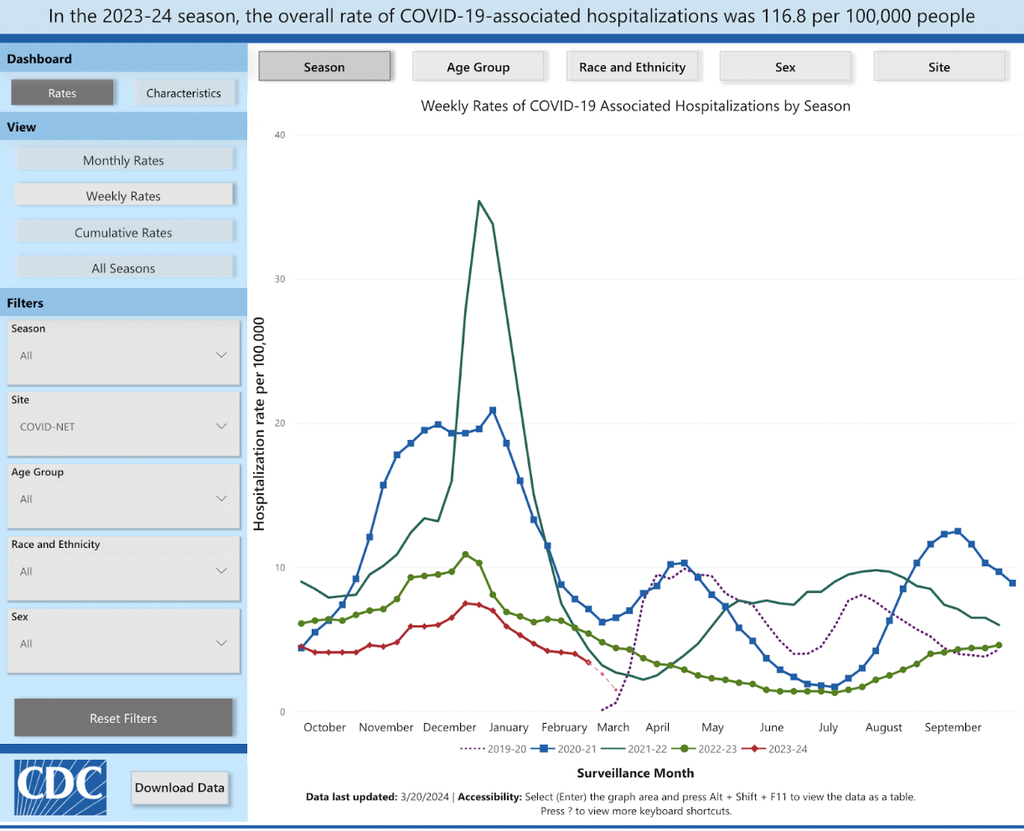(Translated by Google) Good service and kindness Edith is a very kind person (Original) Buena atención y amabilidad Edith es una persona muy amable
Read More
How Many People Have Died From COVID?
Posted: Apr 8th, 2024 at 12:00AM

In late 2019, COVID-19 first made its appearance in the city of Wuhan, China. Seemingly overnight, it spread around the globe, leading to many hospitalizations and fatalities. The lockdown may have ended, and the worst of the pandemic may be behind us, but this coronavirus strain left a lasting mark on the world. How many people have died from COVID? How prevalent were the hospitalizations? Let's break down the numbers.
How Many People Died From COVID-19? The Numbers Say...
The estimated death toll varies based on the source, and some sources have more up-to-date data than others. But here is where we stand, at the moment.
Statista has some of the most current information, stating that as of May of 2023, nearly 6.9 million people had died from COVID-19. Deaths were more prevalent in the United States (1.2 million), followed by Brazil (a little over 700,000), and India (over 531,000).
The World Health Organization (WHO) reported that in January 2020, when COVID-19 was officially declared a Public Health Emergency of International Concern (PHEIC), the official death toll was 171. By December 2020, that number had climbed to more than 1.8 million. However, additional research says that the number of people who had died from COVID was likely closer to at least three million.
The Centers for Disease Control and Prevention (CDC) reports that since January 1, 2020, the total death count for the United States alone is nearly 1.2 million (updated weekly) — more specifically, slightly higher than Statista's most recent data from May of 2023.
Interestingly, men seem to die from COVID-19 at a higher rate than women, although researchers aren't totally sure why. It could have something to do with the timing of surges, state health policies, gender-associated health behaviors, and occupation. However, it's worth noting that differences between the sexes are very sensitive to the context. No one factor can explain it.
An Important Note About This Information
While organizations like the WHO and the CDC are highly reputable sources, it’s important to note that these numbers are still estimates. Many sources agree that plenty of cases of what was probably COVID-19 went undiagnosed and/or unreported.
Additionally, some sources differentiate between deaths caused directly by COVID-19 and deaths due to another cause that may have been exacerbated by COVID-19. More on this in a moment!
Covid 19 Death Rates and Hospitalization Rates by State since 2020
| State/Territory | Total Deaths | Total Death Rate / 100,000 | Hospital Admissions Hospitalization Rate / 100,000 | Hospital Mortality Rate (assuming in-hospital deaths) % |
| Alabama | 23129 | 371.5 | 2,513.77 | 18.01 |
| Alaska | 1577 | 236.9 | 1,436.58 | 14.97 |
| Arizona | 30570 | 334.1 | 2,219.45 | 18.53 |
| Arkansas | 13032 | 351 | 2,380.46 | 17.85 |
| California | 112764 | 254.5 | 1,725.13 | 16.78 |
| Colorado | 15630 | 258.3 | 1,812.56 | 14.67 |
| Connecticut | 12852 | 263.4 | 1,998.96 | 17.77 |
| Delaware | 3661 | 274.4 | 2,127.55 | 16.68 |
| District of Columbia | 1947 | 292.9 | 2,657.25 | 10.79 |
| Florida | 82987 | 258 | 2,694.31 | 13.62 |
| Georgia | 37434 | 328.2 | 2,323.33 | 14.61 |
| Hawaii | 2090 | 104.1 | 1,551.35 | 9.39 |
| Idaho | 5739 | 272.3 | 1,565.97 | 18.65 |
| Illinois | 41954 | 273.1 | 2,020.94 | 16.54 |
| Indiana | 27131 | 341.9 | 2,204.89 | 17.93 |
| Iowa | 11665 | 282.5 | 1,862.61 | 19.53 |
| Kansas | 11021 | 312 | 2,110.22 | 17.76 |
| Kentucky | 21151 | 394 | 3,652.59 | 12.79 |
| Louisiana | 18224 | 341 | 2,250.67 | 17.70 |
| Maine | 3583 | 179.2 | 1,222.66 | 21.00 |
| Maryland | 19119 | 262 | 1,703.55 | 18.16 |
| Massachusetts | 22007 | 247.4 | 1,697.39 | 18.52 |
| Michigan | 39361 | 309.4 | 2,111.33 | 18.57 |
| Minnesota | 16490 | 238.5 | 1,528.24 | 18.81 |
| Mississippi | 15476 | 447 | 2,018.75 | 26.08 |
| Missouri | 23443 | 302.3 | 2,322.99 | 16.29 |
| Montana | 4035 | 280.1 | 2,848.84 | 12.50 |
| Nebraska | 6055 | 260.2 | 1,779.34 | 17.20 |
| Nevada | 12281 | 342.9 | 2,146.00 | 17.92 |
| New Hampshire | 3508 | 190.9 | 1,459.64 | 17.14 |
| New Jersey | 36604 | 313 | 2,063.11 | 19.10 |
| New Mexico | 9686 | 374.3 | 1,950.79 | 23.48 |
| New York | 84120 | 325.3 | 2,150.12 | 19.99 |
| North Carolina | 35733 | 285.7 | 1,702.89 | 19.37 |
| North Dakota | 2736 | 293.4 | 2,116.40 | 16.49 |
| Ohio | 51758 | 347.9 | 2,410.93 | 18.21 |
| Oklahoma | 20354 | 444.1 | 2,886.14 | 17.40 |
| Oregon | 9864 | 187.7 | 1,233.61 | 18.89 |
| Pennsylvania | 55049 | 308.3 | 2,078.02 | 20.44 |
| Rhode Island | 4130 | 279.1 | 1,356.16 | 27.79 |
| South Carolina | 22191 | 343.1 | 1,937.97 | 21.31 |
| South Dakota | 3429 | 313.4 | 2,318.57 | 16.09 |
| Tennessee | 29912 | 360.9 | 1,986.15 | 21.13 |
| Texas | 104983 | 365.6 | 2,130.85 | 16.15 |
| Utah | 5745 | 205.7 | 1,499.68 | 11.21 |
| Vermont | 1158 | 132.5 | 1,131.95 | 15.80 |
| Virginia | 24924 | 248.5 | 1,577.58 | 18.13 |
| Washington | 15941 | 184 | 1,093.19 | 18.66 |
| West Virginia | 9056 | 364 | 2,686.90 | 19.04 |
| Wisconsin | 17966 | 242.8 | 2,327.64 | 13.06 |
| Wyoming | 2254 | 320.6 | 2,085.41 | 18.51 |
How Many People Have Been Hospitalized for COVID-19?
The CDC has an interactive dashboard displaying hospitalizations over time.

Interestingly, with the exception of the year COVID was first announced, hospitalization rates seem to be highest during the coldest months — November, December, and January — before dropping off again, coinciding with flu season.
At the time of writing, hospitalization rates are the lowest for this time of year than they were the three seasons prior — eight individuals for every 100,000.
While getting a total count is difficult, NBC News (using seven-day averages) says that in January of 2024, COVID-19 hospitalizations peaked at 30,580. Hospital rates have been the highest in North Carolina (1,658) and Maryland (1,001). South Dakota has seen the biggest increase in the number of hospitalizations (up 50% from four to six), and Minnesota has seen the biggest decrease (down 73%, from five to one).
Do People Really Die From COVID-19?
As we mentioned earlier, while COVID-19 — in and of itself — can be fatal, it's not always that straightforward. The CDC interviewed Robert Anderson, Chief of Mortality Statistics at NCHS. As Anderson explained, “In almost all cases, COVID-19 leads to some other complications, even if there are pre-existing chronic diseases. So for those that die from COVID-19, COVID almost always initiates a sequence of conditions and those can include respiratory, cardiovascular, and neurological complications.
What that means is, more often than not, someone acquires COVID-19, which causes one or more other health issues, and those ultimately end up being fatal.
How Deadly is COVID-19 Today?
Perhaps unsurprisingly, COVID-19 isn’t as threatening as it was at the onset.
According to Medscape, it was the third leading cause of death for Americans in 2020 and 2021. But by 2023, it was the fourth leading cause.
There are probably a few reasons for this. For starters, somewhere in the neighborhood of 70.6% of the world's population has gotten at least one dose of a COVID-19 vaccine. 13.57 billion doses have been given around the world, and 8,112 are administered every day. These vaccines have helped slow the spread of the coronavirus, protecting our families and communities.
Second, while we haven’t reached herd immunity, it does stand to reason that because so many people have been infected, it's provided some degree of additional immunity, albeit temporarily.
Third, it's possible that overall, we’re more mindful of practicing good hygiene and social distancing. Out in the world, you can still find people wearing masks. Many businesses started encouraging better sanitation practices — for example, by offering hand sanitizer to customers — and continue to do so today. And immunocompromised and elderly people are probably more cautious than they previously were. For instance, some elderly living communities still practice social distancing and limit how many guests can come and go.
And finally, COVID-19 testing is more accessible and affordable. While it was difficult to find testing during the height of the pandemic — something that required you to physically drive to a testing facility — many tests are now available at local stores at pharmacies for around $20 a box.
Will COVID Ever Go Away?
In general, coronavirus has been plaguing us for a long time, accounting for a significant percentage of the common cold. It just so happened that a particular strain came about to cause a pandemic. In all likelihood, COVID-19 is here to stay. However, over the years, it has been likened to the flu, although research continues. It’s fairly prevalent and outcomes may be improved if caught early and addressed accordingly. However, it can be serious and escalate into more severe and long-lasting health issues.

OMG, so e7 is one-of-a-kind in Vegas. My husband needed a TB Skin Test and I was able to book for the next hour. The staff actually answers the phone, right away. They are kind and nice. Upon arrival, at e7 Windmill location, the receptionist (who's name I do not have) was so kind, nice, and caring. She's a gem. During our brief wait for my husband's appointment, I witnessed the interaction between staff members and also, their clients. It's amazing that the entire, big e7 Team loves each other and what they do. You do not see this anywhere else. The team's interaction was magical. AND then how each staff member interacts with their patient, well... just unique. My husband had Alia, who definitely folded her Angel Wings in to fit in to the treatment room. What an amazing being. So patient, as my husband was on a walker and not so ambulatory. She explained all so clearly and easily. Truly, we have never experienced such CARE not just in Vegas, but anywhere. She also went above-and-beyond for us as to the next step. e7 scared me at first online, but now, they are my Go To and I have already recommended to many. God bless Alia and all. The Team truly LOVE what they do and it shows.
Read More

















